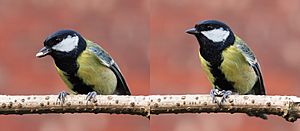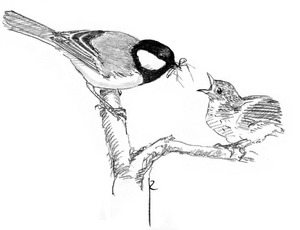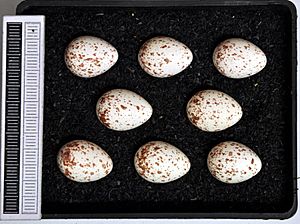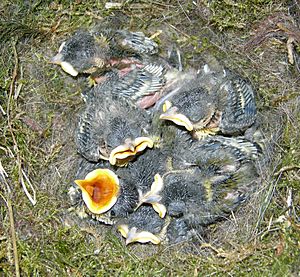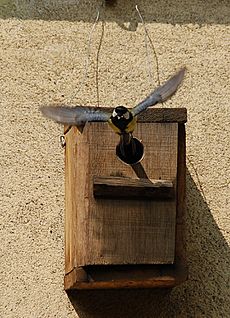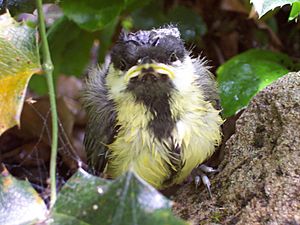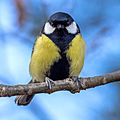Great tit facts for kids
The great tit (Parus major) is a small bird that belongs to the tit family. You can find these birds all over Europe, the Middle East, Central and Northern Asia, and parts of North Africa. Most great tits stay in one place and do not migrate, unless the winter is very harsh.
This bird has a black head and throat. Its back is olive-green, and its belly is yellow. It also has a white patch on its cheek. A great tit is about 12.5 to 14.0 cm long and weighs between 16 and 21 grams. It is known as a songbird because it can make up to 40 different kinds of songs and sounds!
In the summer, great tits mostly eat insects and spiders. For example, they enjoy eating cockroaches and grasshoppers. The female great tit lays about 12 eggs and keeps them warm by herself. Both parents then work together to take care of the baby birds. They feed their young, called fledglings, with lots of protein-rich caterpillars.
Behaviour
What Great Tits Eat
Great tits mainly eat insects and spiders during the summer. They find these by looking closely at leaves. Some of the small creatures they eat include cockroaches, grasshoppers, flies, beetles, and snails. When they have babies, they especially like to feed them caterpillars, which are full of protein.
In colder months, they also eat seeds and fruits from trees and bushes. They love seeds from beech trees and hazelnuts. If there are bird feeders around, they will happily eat scraps, peanuts, and sunflower seeds. In very cold winters, they might eat a lot of sunflower seeds, sometimes up to 44% of their own body weight! They often look for food on the ground, especially when there are many beech nuts. Great tits sometimes join groups of different bird species to find food in winter.
For big food items, like large seeds or insects, great tits use a special trick. They hold the food with one or both feet and then hit it with their beak until it breaks into smaller pieces. This is called "hold-hammering." A great tit can open a hazelnut in about 20 minutes using this method. When feeding their young, adult great tits will even remove the heads of large insects or the insides of caterpillars to make them easier for the chicks to eat.
Great tits are very smart birds. They can figure out problems using their intelligence, not just by trying things until they work. In England, great tits learned to open the foil caps on milk bottles left on doorsteps to get the cream inside. This amazing behaviour was first seen in 1921 and quickly spread to other great tits over the next 20 years!
Life Cycle and Reproduction
Great tits usually have one partner for breeding and set up their own special areas, called territories. They start claiming these territories in late January and protect them in late winter or early spring. They often use the same territory year after year, especially if they successfully raised their young there. However, if their nest was attacked by a predator the year before, the female might move to a new territory.
Great tits breed at certain times of the year. The exact time depends on where they live. Most breeding happens between January and September. In Europe, they usually start breeding after March. Things like how much sunlight there is and the temperature can also affect when they breed. One study found that the time they lay eggs matches when there are the most caterpillars, which is also linked to temperature. Younger female birds tend to lay their eggs later than older ones.
Great tits build their nests in holes, usually inside trees. Sometimes, they might use a hole in a wall or a rock. They also love to use nest boxes that people put up for them. The female builds the nest inside the hole using plant fibers, grass, moss, hair, wool, and feathers. They often lay many eggs, sometimes as many as 18, but usually between five and twelve. If they start laying eggs later in the season, or if there are many other birds competing for space, they might lay fewer eggs. Second groups of eggs (called second broods) also tend to be smaller.
The eggs are white with red spots. The female bird does all the work of keeping the eggs warm (this is called incubation). The male brings her food during this time. She sits very tightly on the eggs and will even make a hissing sound if something disturbs her. The eggs hatch after 12 to 15 days.
When great tit chicks hatch, they have no feathers and cannot see. As their feathers start to grow, their plumage (feathers) has bright colours, similar to their parents. This is unusual for baby birds, as most are dull-coloured to hide from predators. The back of their neck is yellow and reflects ultraviolet light. This might help parents find them in dim light, or it could be a sign that the chick is strong and healthy. This yellow patch turns white after their first moult (when they shed old feathers) at two months old, and it gets smaller as the bird grows.
Both parents feed the chicks, usually giving them about 6 to 7 grams of food each day. Both parents also help keep the nest clean by removing waste. The chicks stay in the nest for 16 to 22 days. After they leave the nest (this is called fledging), they are independent from their parents about eight days later. However, the parents might continue to feed them for a while, sometimes up to 25 days for chicks from the first group of eggs, and even up to 50 days for chicks from the second group. Chicks from the second group of eggs often have weaker immune systems and are not as strong as those from the first group, so fewer of them survive.
Images for kids
-
A nest box in Altenbeken, Germany.
See also
 In Spanish: Carbonero común para niños
In Spanish: Carbonero común para niños


